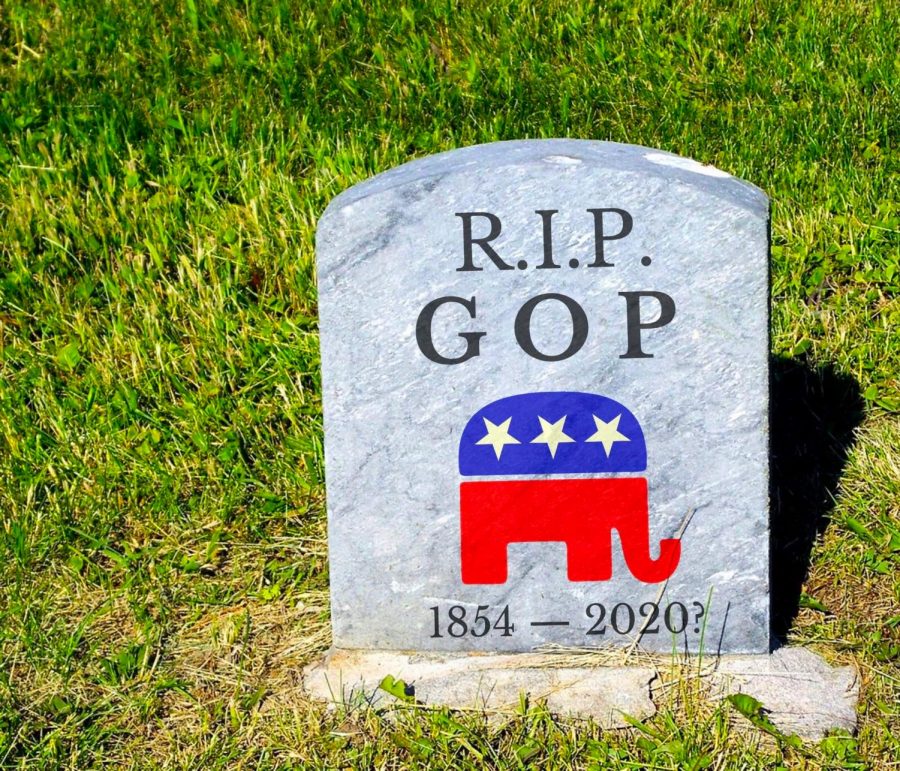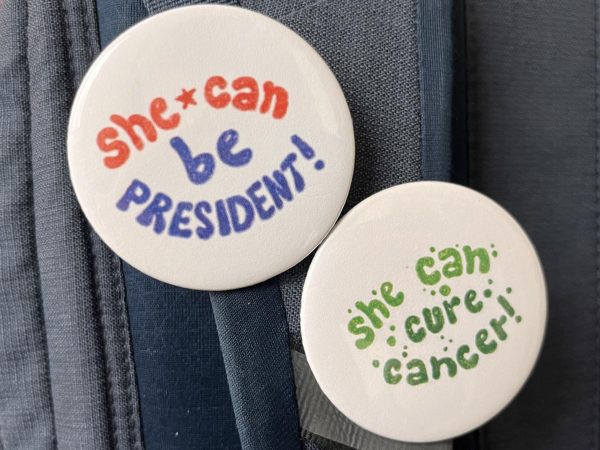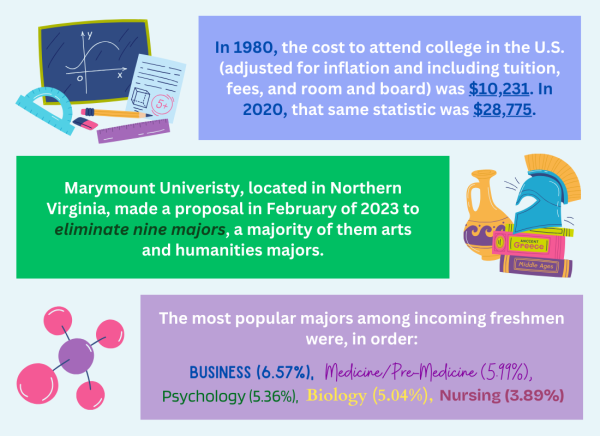The Death of the GOP
The demise of the Republican Party, and how redefining its demographic appeal could save its uncertain future
November 3, 2020
Let’s face it; the Republican Party is in trouble. Regardless of this election’s outcome, the future does not look good for the party of Lincoln. With baby boomers comprising the majority of its voter base, it lacks a sustainable business model.
According to a report by Pew Research Center, millennials are two times more likely to register as democrat than republican. And as democratic leaders have taken a stronger stance for social justice, younger voters have flocked to the left in droves.
In response to this trend, older generations reacted by voting red with increasing consistency. Leaders of the Grand Old Party— quick to smell blood— thrusted themselves on board by stressing policies especially attractive to these elderly voters.
This has produced some success for the Republican Party: it provided the edge of support in 2016 needed to land Trump in the oval office. But that marginal victory came at a severe cost— the alienation of younger voters and those who are not white, evangelical Christians. The impact of this will certainly be felt in the 2020 election, and will only become more pronounced as time passes.
By zeroing in on white, elderly, and religious voters, the Republican Party has driven away a significant part of its potential voter base— the same sectors it must secure to survive past the next few decades. Acting alone, the GOP’s narrow voter base can do little to support the party’s future. With increasing ethnic diversity in the country, and apostasy among Christian youth at an all-time high, the white, Christian voter constituency is decaying at both ends.
Since 2016, Republican policy has been based less on specific economic, social, or political ideology, and more on the particularly volatile emotions of President Donald Trump. This is dangerous not only to the American public, but also to the interests of the GOP. The president is an especially polarizing figure, even among Republicans; and while drawing passionate support, he has had the effect of solidifying the Republican Party’s transformation from a political identity to a cultural one.
To avoid becoming a party of the past, the GOP has no choice but to make some deliberate, and perhaps fundamental changes in its approach to rounding up supporters. Most vitally to its cause, it needs to attract a new set of voters more representative of the nation’s demographics.
Since the party is currently digging its own grave, step one is to just put down the shovel.
How can it achieve this? The answer is not complicated. Since the party is currently digging its own grave, step one is to just put down the shovel.
Since the party is currently digging its own grave, step one is to just put down the shovel. Instead of chaining themselves to trends that ensure their future demise, Republican leaders will need to open their minds to something that may seem foreign: data, and most critically, logic.
Solving the GOP’s woes would mean shaping up its game where it is currently failing the most— by using demographic shifts to its advantage. Because the party’s primary instruments are its policy and outward appearance to the public, it must look into how it can manipulate these to grow its appeal among crucial demographics.
Naturally, an exhaustive ideological overhaul would be both harmful and self-defeating: too sharp a swing would turn off its voters, and by changing its basic principles, they might as well vote democrat. But such substantial reform is not only impractical but unnecessary; this is why subtlety and tact regarding policy formulation will be the key to future Republican political strategy.
Through only minor policy changes, imperceptible to most of its voter base, and a strategically adjusted public presence, the GOP could still attract youths from broader demographics, and voters from the blue-leaning group of college-educated Americans. While the Democratic Party has done very well at attracting sustainable demographics, it is surprisingly not number one. Inspiration to guide Republican reform may instead have to come from an unexpected place: the Libertarian Party.
Most know it is the third largest political party in the United States. Surprisingly, it’s also the country’s fastest growing political party, with voter registration swelling 92% between 2008 and 2018. Most significantly, this voter base is the youngest of any party. This sunny demographic forecast Libertarians have is something valuable that Republicans do not.
Now, this is not an endorsement of Libertarian politics, nor of any politics— even Republican or Democratic. This is simply an analysis as to what works and what does not in the current political climate, and how the GOP can avoid its destiny to crash and burn.
To the public, Libertarian beliefs seem vague and without direction— often because they are. However, its supporters generally follow the motto, “fiscally responsible, socially tolerant.” Between democrats and republicans, this is an almost non-existent combination in the mainstream 2020 political scene.
In the battle of social values, Libertarianism’s “social tolerance” seems to have already prevailed. While the Democratic Party is obviously and invariably seen as progressive, it’s easy to ignore how much change has occurred within the Republican Party, and how socially tolerant it has actually become— even while it’s still conservative compared to the Democratic Party. Looking at America as a whole, the victory of social progressivism is dramatic.
Take an example: same-sex marriage. Today, nearly 7 out of 10 of americans voice approval for same-sex marriage, which is almost a 30% increase from two decades ago. This was an issue long supported by Libertarian activists. Following the deployment of the National Guard to Portland, the recent surge in opposition to police brutality and federal government overreach aligns neatly with the Libertarian partiality to limited government, and its antipathy for federal supremacy.

Put simply, the Libertarians have succeeded where Republicans failed the most: in appealing to the country’s social conscience. Because social progressivism is bound to define the future of America’s socio-political frontier, the Republican Party has only to acknowledge the present trends and acquiescently jump aboard to end its period of demographically- founded decline.
By easing on certain fronts such as government-enforced “family values”, and instead developing a more socially tolerant persona, the GOP could go far. Granted, this would be painful for some hardcore conservatives, but generally speaking from their perspective, these are battles that have already been lost. It is indeed difficult to imagine Mitch McConnell shifting towards moderate, but as a general trend it is not altogether out of the picture.
During the second Bush administration, arguably the biggest partisan issue was waging war in the Iraq and Afghanistan era. Today, Trump’s distaste for involvement in foreign affairs is markedly uncharacteristic of the GOP as defined by Bush; if anything, it is more democratic or libertarian than traditional Republican. Yet the president continues pulling troops from the Middle East, and Republicans cheer him on.
This profound shift in ideology shows that significant and even radical change can indeed occur within a party, even within a short period of time. Because of this, it is not unreasonable to believe that the GOP still has a chance to get back in shape and play a dominant role in future politics.
More often than not, republicans are not the irredeemable fascists or homophobes some paint them to be. In fact, Republicans have seen the same increase in approval of same-sex marriage as has the rest of the country. The social tolerance requisite to attract more socially- conscious voters, in many cases, already exists within the GOP. The party’s rhetoric just has to align with these beliefs. If the Republican Party is comfortable being relatively progressive in social values, why turn off potential ideological allies by spurting out rhetoric inconsistent with its general beliefs?
To provide an example, illegal immigration is an issue that has more to do with rhetoric than numbers and policy. The number of deportations during the first three years of the Obama administration was nearly 1.2 million people, while those under the Trump administration barely exceeded 800,000. While Trump has repeatedly stated his support for legal immigration, it is natural that immigrants would view him as nativist and xenophobic.
A president’s respectful tolerance towards immigrants, even illegal ones, would not be new for the Republican party. Ronald Reagan followed this sentiment, and George H.W. Bush epitomized it. Donald Trump, though, not so much.
Is he a racist? Maybe or maybe not. But by chanting “build the wall” and “send them back,” his supporters haven’t exactly made immigrants feel welcome in the GOP. By rethinking the Republican approach to discussing immigration— and not, necessarily, even the policies regarding it— the GOP as a whole would fare much better.
By projecting an improved sense of social tolerance, the GOP could secure just enough votes to turn Florida equably red.
Look at Florida, for example. It is a key battleground state in presidential elections, providing 29 electoral votes. It is also home to roughly 1.6 million Cubans, immigrants who, in many cases, immigrated to America due to the failures of Cuba’s socialist government. Theoretically speaking, they should be easy to secure as Republican voters, given the party’s fundamental principle of limited government and pro-capitalist economics. Indeed, this has been the case for years. Both senators Ted Cruz and Marco Rubio are of Cuban descent.
However, likely as a result of anti-immigration rhetoric, members of this population are voting increasingly blue. By projecting an improved sense of social tolerance while continuing to stress the Republican values of small government and personal freedom, which tend to contrast socialism, the GOP could secure just enough votes to turn Florida equably red.
Additionally, by maintaining integrity and continuity in its policy decisions, the party could attract another set of voters through ideological persuasion. Although socialistic policies are gaining momentum, the logic of fiscally conservative economics may hold a similar, alternate intellectual appeal.
College-educated Americans, a group leaning strongly and increasingly to the left, could find the economic logic and rationality of fiscal conservatism alluring. However, to be explored by these curious minds, it would first have to become more palatable.
And the truth is, young Americans have a pretty predictable palette. They want to make a difference; they want to change the world for the better. Most importantly, they want to see themselves as instruments of positive change, because it makes them feel important and valuable to society as a whole. It’s no secret how this typically plays out. The appearance of compassion and humanitarianism inherent in social progressivism make the Democratic Party the popular choice. But, to the potential gain of the GOP, this isn’t a hard and fast rule.
Today, most youth see the laissez- faire concept of “trickle-down” economics as an inhumane wealth grab by the rich. 40 years ago however, these same economic principles rocketed candidate Ronald Reagan to the presidency with the support of over 60% of college students. During the 1980s, the GOP was the primary party for young Americans.
A common sentiment was that “Reagan made me feel proud of my country again.
What changed? More than anything, it was the party’s approach to its beliefs— how they were presented. “Reaganomics,” a full incarnation of the trickle-down theory, was aimed at helping every American: the poor and working class, as well as the wealthy. It followed the belief that cutting taxes would help float every boat, and was a message of unity between classes where all Americans would benefit.
The biggest selling point was the sense of optimism, positivity, and patriotism Reagan and his party pumped into it. This sort of presentation worked; the strategy was a booming success. A common sentiment among youth was that “Reagan made me feel proud of my country again.”
Like many current Democratic policies, it channeled into young American’s hope for the future and their longing to make a difference. This same sense of meaning for youth is a resource just as strong and accessible today. Youth have not changed, but the Republican Party still can.
This story was originally published on Inkwell on November 2, 2020.































![IN THE SPOTLIGHT: Junior Zalie Mann performs “I Love to Cry at Weddings,” an ensemble piece from the fall musical Sweet Charity, to prospective students during the Fine Arts Showcase on Wednesday, Nov. 8. The showcase is a compilation of performances and demonstrations from each fine arts strand offered at McCallum. This show is put on so that prospective students can see if they are interested in joining an academy or major.
Sweet Charity originally ran the weekends of Sept. 28 and Oct. 8, but made a comeback for the Fine Arts Showcase.
“[Being at the front in the spotlight] is my favorite part of the whole dance, so I was super happy to be on stage performing and smiling at the audience,” Mann said.
Mann performed in both the musical theatre performance and dance excerpt “Ethereal,” a contemporary piece choreographed by the new dance director Terrance Carson, in the showcase. With also being a dance ambassador, Mann got to talk about what MAC dance is, her experience and answer any questions the aspiring arts majors and their parents may have.
Caption by Maya Tackett.](https://bestofsno.com/wp-content/uploads/2024/02/53321803427_47cd17fe70_o-1-1200x800.jpg)
![SPREADING THE JOY: Sophomore Chim Becker poses with sophomores Cozbi Sims and Lou Davidson while manning a table at the Hispanic Heritage treat day during lunch of Sept 28. Becker is a part of the students of color alliance, who put together the activity to raise money for their club.
“It [the stand] was really fun because McCallum has a lot of latino kids,” Becker said. “And I think it was nice that I could share the stuff that I usually just have at home with people who have never tried it before.”
Becker recognizes the importance of celebrating Hispanic heritage at Mac.
“I think its important to celebrate,” Becker said. “Because our culture is awesome and super cool, and everybody should be able to learn about other cultures of the world.”
Caption by JoJo Barnard.](https://bestofsno.com/wp-content/uploads/2024/01/53221601352_4127a81c41_o-1200x675.jpg)














